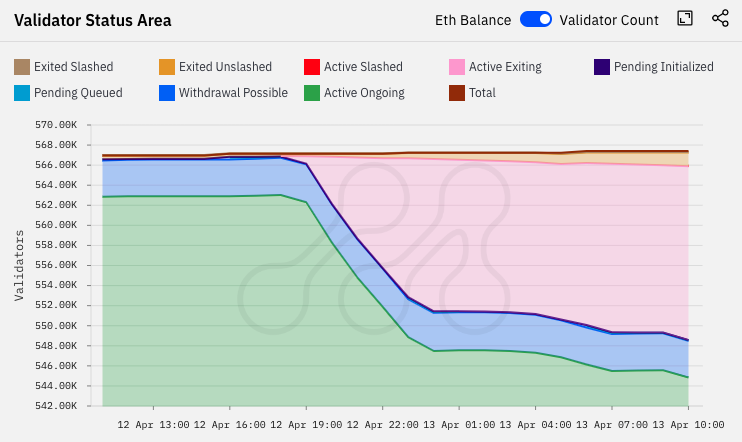Ethereum Unstaking Requests Pile Up After Shanghai Upgrade, Now at 2-Week Wait
Featured SpeakerDeep Dive: Ethereum
Protocol VillageAustin Convention Center

Join an hour long exploration of the advancements defining the Ethereum community in 2023.
:format(jpg)/www.coindesk.com/resizer/Kjea5zGf89qzyacI8fZ49yhnaks=/arc-photo-coindesk/arc2-prod/public/S7SPGELTNBFITA3UBCS2CMRBQM.png)
Margaux Nijkerk reports on blockchain protocols with a focus on the Ethereum ecosystem. A graduate of Johns Hopkins and Emory universities, she has a masters in International Affairs & Economics. She holds a very small amount of ETH and other altcoins.
Featured SpeakerDeep Dive: Ethereum
Protocol VillageAustin Convention Center

Join an hour long exploration of the advancements defining the Ethereum community in 2023.
So many Ethereum validators have put in requests to unstake ether (ETH) from the blockchain following Wednesday’s Shanghai upgrade that the queue to get the cryptocurrency out has backed up to two weeks.
In the hours following the Shanghai upgrade, also referred to as Shapella – the “hard fork” or series of blockchain code changes that enabled staked ETH withdrawals for the first time – the number of validators waiting for redemptions has grown to about 17,000 for full withdrawals, and 285,000 for partial withdrawals, according to the network explorer Rated. (There’s not total agreement in the market about this number; the blockchain analysis firm Nansen estimates it at about 22,000 for full withdrawals, while an Ethereum Foundation-sponsored data dashboard on the website Metrika also puts the number around 17,000.)
The total number of validators is about 567,000, according to Nansen, so the ones waiting for full withdrawals represent just 4%. A full withdrawal is when validators request back their entire original deposit of 32 ETH (about $64,000 worth), the amount that’s required to participate in the proof-of-stake network.
But also, the Ethereum blockchain appears to be processing the withdrawals at just 55.4% of its capacity, according to Rated.
The upshot is that there’s about a 14-day wait. That’s quite a bit longer than several blockchain analysts’ estimates prior to Shanghai – that it could take a few hours to a few days to get through the backlog.

Chart shows status of Ethereum validators post-Shanghai. The pink zone represents those “active exiting.” Note scale of chart is truncated, with vast majority in green or “active ongoing.” (Metrika)
Roughly 1,000 validators have fully exited the Beacon Chain.
Blockchain analysts have noted that validators associated with Kraken, the crypto exchange, make up about 80% of that queue. That dynamic was expected, since Kraken agreed in February to shut down its staking service in a settlement with the Securities and Exchange Commission.

The Rated Network explorer shows that Kraken makes up the majority of validators looking to exit the Beacon Chain (rated.network)
While stakers are starting to withdraw their accrued rewards, Nansen, a blockchain analytics provider, shows that ether (ETH) deposited into the Beacon Chain has started to grow, showing that stakers want to participate in Ethereum’s maintenance of the blockchain going forward.
But on a net basis, withdrawals still outweigh the deposits. The 24 hour net deposit change into the Beacon Chain currently stands at minus 79,488 ETH (minus 0.4%) at the time of publication.

Chart of ETH Deposits vs Withdrawals into Ethereum’s Beacon chain (Nansen)
Data about the Shanghai Upgrade will still be rolling in as more liquid staking providers also allow its users to withdraw their staked ETH.
Later Thursday, Coinbase, a cryptocurrency exchange which holds about 12.6% of all staked ETH, will allow its users to decide if they want to unstake.
Ethereum developers met today to debrief on Shanghai.
“Great work everyone on Shapella, it worked!” Tim Beiko, the protocol support lead at the Ethereum Foundation, said at the Ethereum All Core Developers execution layer meeting 159. “The network transitioned successfully. There were a couple minor issues that we saw, but I think overall this was very smooth, and great work everyone!”
ETH is up about 5% over the last 24 hours and rose to $2,003 earlier today, reaching the highest point since August.
DISCLOSURE
Please note that our
privacy policy,
terms of use,
cookies,
and
do not sell my personal information
has been updated
.
The leader in news and information on cryptocurrency, digital assets and the future of money, CoinDesk is a media outlet that strives for the highest journalistic standards and abides by a
strict set of editorial policies.
CoinDesk is an independent operating subsidiary of
Digital Currency Group,
which invests in
cryptocurrencies
and blockchain
startups.
As part of their compensation, certain CoinDesk employees, including editorial employees, may receive exposure to DCG equity in the form of
stock appreciation rights,
which vest over a multi-year period. CoinDesk journalists are not allowed to purchase stock outright in DCG
.
:format(jpg)/www.coindesk.com/resizer/Kjea5zGf89qzyacI8fZ49yhnaks=/arc-photo-coindesk/arc2-prod/public/S7SPGELTNBFITA3UBCS2CMRBQM.png)
Margaux Nijkerk reports on blockchain protocols with a focus on the Ethereum ecosystem. A graduate of Johns Hopkins and Emory universities, she has a masters in International Affairs & Economics. She holds a very small amount of ETH and other altcoins.
Learn more about Consensus 2023, CoinDesk’s longest-running and most influential event that brings together all sides of crypto, blockchain and Web3. Head to consensus.coindesk.com to register and buy your pass now.
:format(jpg)/www.coindesk.com/resizer/Kjea5zGf89qzyacI8fZ49yhnaks=/arc-photo-coindesk/arc2-prod/public/S7SPGELTNBFITA3UBCS2CMRBQM.png)
Margaux Nijkerk reports on blockchain protocols with a focus on the Ethereum ecosystem. A graduate of Johns Hopkins and Emory universities, she has a masters in International Affairs & Economics. She holds a very small amount of ETH and other altcoins.









